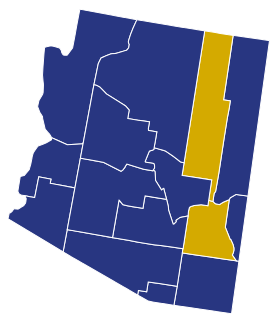“Turn Arizona Blue” has been the rallying cry of grassroots Democrats canvassing voters across the Southwest for the past decade in an attempt to repeat Bill Clinton’s surprising win of the traditionally red state back in 1996. Hillary Clinton attempted to pay more attention to winning the state’s 11 electoral votes, dispatching political operatives to gather endorsements and fundraise. When the strategy failed to win the state, former Governor Janet Napolitano said, “The fact of the matter is that if the Latino population voted at the same percentage as the white population, Arizona would be a blue state now.” This shows just how invested Democrats are in the idea of a blue Southwest.
But Hillary Clinton’s attempt to play ball with Arizona moderates only led to the state being won by Trump in 2016. The president’s approval rating in the state is hovering around 42 percent; that number either matches the national average or is slightly above it, depending on which polls you look at. Going even further, Arizona has been a solid team player for the Republican party, voting with the GOP on every federal election, except for 1996, since 1952.

So why are Democrats so interested in us now? The answer is one word; demographics. For decades, Arizona has been one of the most affected states by the increase in Hispanic immigration, with the number of Latinos jumping from 25 percent of the state population in 2000 to almost 30 percent in 2010. These Hispanic voters tend to migrate to the Democratic party, who more consistently vote in favor of easing immigration barriers and who often make common causes with Hispanic interests.
With Arizona’s population now almost a third Hispanic, Democrats have begun to see blood in the water for the traditionally dominant Republican party in the state and have jumped at the opportunity to offset the now surprisingly competitive Rust Belt for a more receptive Southwest. But Democratic aspirations lean heavily on faulty assumptions. Even as Arizona has become more and more Hispanic, the state has been matching the average Republican lead in each election. If a political reorganization were right around the corner, we should be able to see the Republican lead drop in each election, but it is instead deeply consistent, at around 54 percent every election cycle.
RELATED: Opinion: Some students find violence appropriate end to offensive speech
Only in 2016 did this number begin to change, and even then it does not lend credibility to the Democratic party’s push. While the Republican vote percentage drops to around 49 percent, Democrats are still only capable of winning 45 percent, virtually identical to the amount they won in 2008 at the height of a nationwide Democratic near-landslide.
Only the Libertarian party saw a noticeable increase in vote percentage, jumping up to 4 percent and taking many of the disaffected voters with them — all this despite constant Democratic attention, the divisive rhetoric of the candidates and the near unanimity of the Latino community against Donald Trump. If 2016 was supposed to be the wake-up call for Republicans about losing the Southwest, all it proved was that the Democratic party has a lot of restructuring it needs to do before it can be considered an agreeable alternative.
RELATED: Opinion: Trump across the aisle
Even as Republican Senator Jeff Flake begins cautiously eyeing up his reelection, his focus is not on any opponent on the left. Instead it’s the right wing of his own party that serves as the more immediate threat to the freshman senator. With only a 25 percent approval rating in his own party, more populist-right primary challenger Kelli Ward is currently besting him in state-based polls 58 percent to 31 percent.

Flake may have another year to win over his own party, but his greatest threat is not the demographic shift that Democrats have so gleefully attempted to grasp onto. It shows just how backwards the Democratic party has it. If they really want to turn Arizona blue, they cannot attempt to let population trends do all the work for them. Bill Clinton didn’t win the state in 1996 by increasing the Mexican population of the state; he did it by making a rational and involved appeal to the moderate Republicans and unaffiliated across the state, as well as appealed to the disaffected members of his own party. If left-leaning candidates took a page from his book today, they may find an audience eager for change in leadership and the opportunities afforded by competitive state elections.
— Alec Scott is a sophomore studying political science who volunteered in the 2012 Ron Barber congressional campaign.
Follow The Daily Wildcat on Twitter









